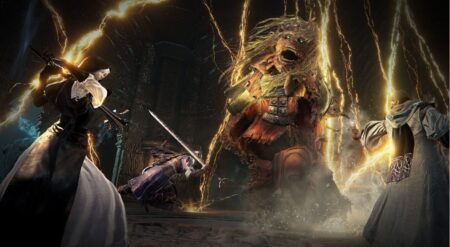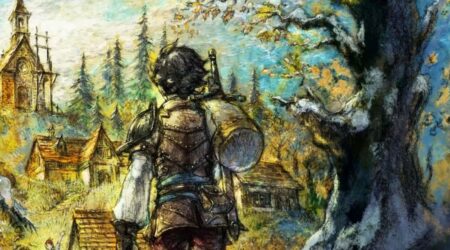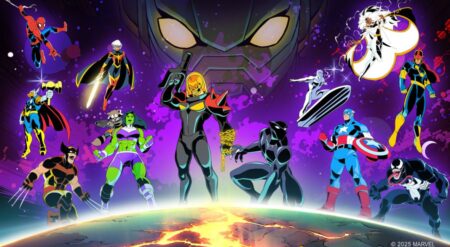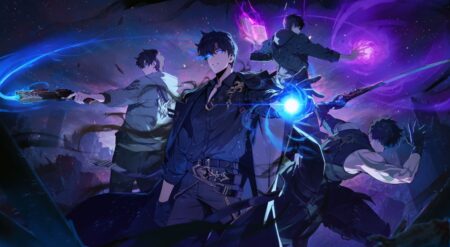
Marvel’s Avengers are one of the biggest licenses in pop culture right now. They are everywhere. And while they are present in publisher 2K Games and developer Firaxis Games’ turn-based tactics RPG Marvel’s Midnight Suns, they are not in the spotlight. Rather, for this unique blend of strategy, RPG elements, and social simulator, the game focuses on more obscure characters who form up the game’s namesake team, as well as an all-new character made just for the player, The Hunter.
The basic premise of the plot goes like this: 300 years ago, Lilith, The Mother of Demons, sought to enslave the world. The only force that was able to stop her was her half-human, half-demon child, The Hunter. But The Hunter perished along with her mother. Now, in the present day, Hydra has resurrected Lilith. Having failed to defeat her during their first confrontation, the Avengers are forced to seek the help of the mystical team, the Midnight Suns, as well as the long-dead savior they have sleeping on the grounds of their base, The Abbey. But The Hunter’s resurrection does not go as smoothly as Lilith’s, and it will take a bit of work before she’s ready to put her mom back in the ground.
While the short-form version of Marvel’s Midnight Suns may sound like your simple race-against-darkness plot, there is a lot more going on than just a battle against evil. Paced more like a season of television or a long comic book run, this story sees subplots ranging from searching for ways to rescue allies, personality clashes between its two starring teams, as well as the search for The Hunter’s lost memories. There is even a light romance storyline between two of the heroes.
I found all the major storylines that weave through this game ranging from fun to compelling. Every character brings a unique personality to the table, and seeing how Firaxis makes them blend and mix is a delight. Even some of the old standbys get some interesting wrinkles to their personalities here. While Tony Stark is still the insufferable know-it-all made famous by the MCU, it’s revealed here that Tony has a hard time dealing with the metaphysical. Science has rules he can control and manipulate, magic isn’t so clear. The writers have a ton of fun at the character’s expense, as did my version of The Hunter.
Within all of these narratives, as one would expect, The Hunter tends to end up in the center of everything. Given that they just woke up from a 300-year-long dirt nap, this leaves the player in a unique position. As the character is effectively a blank slate, Marvel’s Midnight Suns allows as fresh of a perspective as one could hope for. Whose side The Hunter takes throughout the game is totally up to the player, and Firaxis does a great job of not making one side or the other out to be the bad guys in these situations. There are often times someone is at fault, but it is generally because they are trying to do the right thing, or following the paths their life experiences have taught them to be necessary.
As you navigate these social waters, your choices will soon have The Hunter forming friendships with those characters they are able to get along with. These friendships are enjoyable to see take shape in the social side of the game, but they also unlock meaningful combat bonuses that will help you win through many of the game’s toughest battles. However, while these bonuses are useful, you don’t need to try to please everyone to survive on the battlefield. The game allows players to strengthen their characters through ways that are separate from the social system as well. So if Tony is bugging you, feel free to let him know.
Once the talking ends, the fighting begins. Marvel’s Midnight Suns offer one of the most unique battle systems I’ve seen in a turn-based tactics game in a long time. But its uniqueness is only part of what makes it great. What truly makes it shine is that it feels perfectly engineered for its superhero subjects.
The first thing about this system is that you will never miss an attack. When superheroes start knocking off Hydra agents, the blows should always land. So they do. Rather than use the time-honored percentage chance-to-hit method of randomizing outcomes most strategy games use, Marvel’s Midnight Suns instead randomizes which actions you will have access to thanks to its card-based action system.
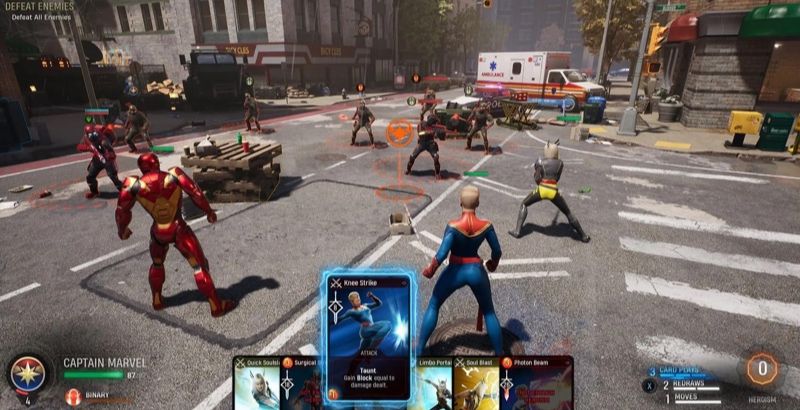
When you go into combat, you will have a team of three characters, usually The Hunter and two others. Each character brings a set of eight actions with them. These actions are all mixed together and at the start of each round of combat, the player is dealt several to use. These actions range from attacks to support skills and even super-powerful finishers that can combine a pair of heroes as they work in unison to thwart the villains. Many of these actions require the player to build up a currency called Heroism over the course of combat rounds. Basic attacks and support actions build up this energy, while bigger Heroic Powers spend it. This creates a nice give and take, making every ability type important in how you manage the flow of a battle.
Each character has its own themes and playstyle, so it is always fun to mix and match to see which characters are the best for which mission type. The teleporter Magik can open portals to knock opponents to the other side of a map with ease, while Captain Marvel’s raw power draws enemies to her, making her the focus of their ire.
Another unique thing about this game’s combat is its focus on the environment. Knocking bad guys off of walls, explosive barrels, or each other is a key element of Marvel’s Midnight Suns’ combat. Setting up angles and being aware of the surroundings allows the player to make the most of any battlefield. Also, the environment always has lots of interactive elements the player can use to master the field. Hanging objects can be dropped on enemies, desks can be kicked, sending them sliding through minions, or boxes can simply be thrown to get that final bit of damage in.
The vast majority of Marvel’s Midnight Suns missions fall into roughly five types. While this sounds like a small number that would cause combat to grow stale, it is a good amount for its gameplay style. With all of the above-mentioned systems needing consideration, too much variance would lead to a lot of battles lost to confusing setups and overcomplicated moments. This is also how I feel about the fairly limited number of enemy types the villains bring to the game’s many battles. I appreciated how quickly Firaxis allowed me to get to know what the bulk of the opposition would bring to battles, allowing me to focus mostly on executing my own plans properly, rather than constantly struggling to keep up with unique unit types and tactics.
Once the dust settles and the heroes return to The Abbey, players get the best rewards of the game: new ability cards. The vast majority of new abilities are earned as rewards for completing missions, and the only characters who can receive them this way are the ones who went on the mission. This further encourages players to mix up their formations so they can make sure every character is strong enough to hold their own. Which is something to keep in mind, as some story missions will require the player to play with a set team.
The final aspect of gameplay that bears mentioning is The Abbey itself. Beyond just being a home to hang out or argue in, the structure and the surrounding grounds offer many of their own interactive aspects. Mysteries can be solved on the external grounds that will help The Hunter grow into the hero they need to be, while numerous areas within The Abbey can be upgraded in a variety of ways. Allowing players to craft helpful consumable items, and improving their training space to help increase their combat skills are just some of the goals players can pursue when at their home base.
The only part of Marvel’s Midnight Suns that I have some mixed feelings about is the visuals. While the combat animations are always fun, and Firaxis does a great job of bringing the wow factor to the heroes’ battles, their time in the social elements is less great. Characters are very wooden in their behaviors, and even facial animations can look a bit off at times. These shortcomings are never particularly damaging to the proceedings in my opinion, but they rarely add much to a moment either.
One thing that helps get the game past its visual shortcomings is the voice acting. I love the personality that every actor brings to their characters here. And while I liked the entire cast’s work, the stand out has to be Nico Minoru, voiced by Lyrica Okano. The voice Okano imparts to Nico is one that is able to adequately project the many nuanced, and sometimes conflicting feelings of the character.
While this has blossomed into a lengthy write-up, there is still so much more I could rave about in Marvel’s Midnight Suns. But suffice it to say, as long as you are looking for deep, turn-based combat, blended with a healthy dose of superhero angst, this game will serve up something special and well worth making time for this holiday season.
Marvel’s Midnight Suns is available now for PC, Playstation5, and Xbox Series S/X.
Marvel's Midnight Suns
-
Rating - 9/109/10
TL;DR
If you are looking for deep, turn-based combat, blended with a healthy dose of superhero angst, Marvel’s Midnight Suns will serve up something special and well worth making time for this holiday season.


